Edmund Hillary
 From Nwe
From Nwe
| Sir Edmund Hillary | |
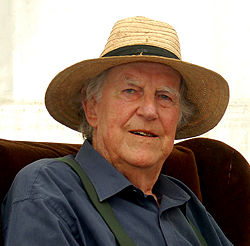
Hillary in 2006
|
|
| Born | July 20, 1919 Auckland, New Zealand |
|---|---|
| Died | January 11, 2008 Auckland, New Zealand |
| Spouse(s) | Louise Mary Rose (1953-1975) June Mulgrew (1989-2008) |
| Children | Peter (1954 -) Sarah (1955 -) Belinda (1959-1975) |
| Parents | Percival Augustus Hillary Gertrude Hillary, née Clark |
Sir Edmund Percival Hillary, Order of the Garter (KG), Order of New Zealand (ONZ), Order of the British Empire (KBE) (July 20, 1919 – January 11, 2008) was a New Zealand mountaineer and explorer. On May 29, 1953 at the age of 33, he and Sherpa mountaineer Tenzing Norgay became the first climbers known to have reached the summit of Mount Everest. They were part of the ninth British expedition to Everest, led by John Hunt.
Hillary became interested in mountaineering while in high school, making his first major climb in 1939, reaching the summit of Mount Ollivier. He served in the Royal New Zealand Air Force (RNZAF) as a navigator during World War II. Before the successful expedition in 1953 to Everest, he had been part of a reconnaissance expedition to the mountain in 1951 and an unsuccessful attempt to climb Cho Oyu in 1952. As part of the Commonwealth Trans-Antarctic Expedition he reached the South Pole overland in 1958. He would later also travel to the North Pole.
Following his ascent of Everest he devoted much of his life to helping the Sherpa people of Nepal through the Himalayan Trust, which he founded. Through his efforts many schools and hospitals were built in this remote region of the Himalayas. The real value of his legacy lies in its inspirational aspects; even as humanity was reaching for the stars[1] some of its highest mountains, deepest oceans and most remote regions remained largely unexplored. Only when humanity fully understands the planet can it rise to the challenge of preserving the earth as a sustainable habitat for all its occupants.
Youth
Hillary was born to Percival Augustus Hillary and Gertrude Hillary, née Clark, in Auckland, New Zealand, on July 20, 1919.[2] His family moved to Tuakau (south of Auckland) in 1920, after his father (who served at Gallipoli) was allocated land there.[3] His grandparents were early settlers in northern Wairoa in the mid[nineteenth century after emigrating from Yorkshire, England.[4]
Hillary was educated at Tuakau Primary School and then Auckland Grammar School.[3] He finished primary school two years early, but struggled at high school, achieving only average marks.[5] He was initially smaller than his peers there and very shy so he took refuge in his books and daydreams of a life filled with adventure. His daily train journey to and from high school was over two hours each way, during which he regularly used the time to read. He gained confidence after he learnt to box. At 16 his interest in climbing was sparked during a school trip to Mount Ruapehu. Though gangly at 6 ft 5 in (195cm) and uncoordinated, he found that he was physically strong and had greater endurance than many of his tramping companions.[6] He studied mathematics and science at The University of Auckland, and in 1939 completed his first major climb, reaching the summit of Mount Ollivier, near Mount Cook in the Southern Alps.[3] With his brother Rex, Hillary became a beekeeper,[2][7] a summer occupation that allowed him to pursue climbing in the winter.[8]
World War II
Upon the outbreak of World War II Hillary applied to join the air force, but withdrew the application before it was considered because he was "harassed by my religious conscience."[9] Following the introduction of conscription on the outbreak of war in the Pacific, in 1943 Hillary joined the Royal New Zealand Air Force (RNZAF) as a navigator and served on Catalina flying boats. In 1945 he was sent to Fiji and to the Solomon Islands where he was badly burned in a boating accident, after which he was repatriated to New Zealand.[9]
Expeditions
Hillary was part of a British reconnaissance expedition to Mount Everest in 1951 led by Eric Shipton before joining the successful British attempt of 1953.
In 1952 Hillary and George Lowe were part of the British team led by Eric Shipton that attempted Cho Oyu. After that attempt failed due to the lack of route from the Nepal side, Hillary and Lowe crossed the Lho-La into Tibet and reached the old Camp II, on the northern side, where all the pre-war expeditions had camped.
1953 Everest Expedition
The route to Everest was closed by Chinese-controlled Tibet, and Nepal only allowed one expedition per year. A Swiss expedition (in which Tenzing took part) had attempted to reach the summit in 1952, but was turned back by bad weather 800 feet (240 m) from the summit. During a 1952 trip in the Alps Hillary discovered he and his friend George Lowe had been invited by the Joint Himalayan Committee for the approved British 1953 attempt and immediately accepted.[10]
Shipton was named as leader but was replaced by Hunt. Hillary considered pulling out, but both Hunt and Shipton talked him into remaining. Hillary was intending to climb with Lowe but Hunt named two teams for the assault: Tom Bourdillon and Charles Evans; and Hillary and Tenzing. Hillary therefore made a concerted effort to forge a working friendship with Tenzing.[10]
The Hunt expedition totaled over 400 people, including 362 porters, 20 Sherpa guides and 10,000 lbs of baggage,[11][12] and like many such expeditions, was a team effort. Lowe supervised the preparation of the Lhotse Face, a huge and steep ice face, for climbing. Hillary forged a route through the treacherous Khumbu Icefall.[10]
The expedition set up base camp in March 1953. Working slowly it set up its final camp at the South Col at 25,900 feet (7,890 m). On May 26 Bourdillon and Evans attempted the climb but turned back when Evans' oxygen system failed. The pair had reached the South Summit, coming within 300 vertical feet (91 m) of the summit.[12][13] Hunt then directed Hillary and Tenzing to go for the summit.
Snow and wind held the pair up at the South Col for two days. They set out on May 28 with a support trio of Lowe, Alfred Gregory and Ang Nyima. The two pitched a tent at 27,900 feet (8,500 m) on May 28 while their support group returned down the mountain. On the following morning Hillary discovered that his boots had frozen solid outside the tent. He spent two hours warming them before he and Tenzing attempted the final ascent wearing 30-pound (14 kg) packs.[10] The crucial move of the last part of the ascent was the 40-foot (12 m) rock face later named the "Hillary Step." Hillary saw a means to wedge his way up a crack in the face between the rock wall and the ice and Tenzing followed.[14] From there the following effort was relatively simple. They reached Everest's 29,028 ft (8,848 m) summit, the highest point on earth, at 11:30 am.[15][2] As Hillary put it, "A few more whacks of the ice axe in the firm snow, and we stood on top."[16]
They spent only about 15 minutes at the summit. They looked for evidence of the 1924 Mallory expedition, but found none.[17] Hillary took Tenzing's photo, Tenzing left [[chocolate[[s in the snow as an offering, and Hillary left a cross that he had been given.[10] Because Tenzing did not know how to use a camera, there are no pictures of Hillary there.[18] The two had to take care on the descent after discovering that drifting snow had covered their tracks, complicating the task of retracing their steps. The first person they met was Lowe, who had climbed up to meet them with hot soup.
| “ | Well, George, we knocked the bastard off. | ” |
—Hillary's first words to lifelong friend George Lowe on returning from Everest's summit[6][10] |
||
News of the successful expedition reached Britain on the day of the coronation of Queen Elizabeth II. The group was surprised by the international acclaim that they received upon arriving in Kathmandu.[10] Hillary and Hunt were knighted by the young queen,[19] while Tenzing received either the British Empire Medal,[16] or the George Medal from the British Government for his efforts with the expedition.[20][21] It has been suggested that Indian prime minister Jawaharlal Nehru refused permission for Tenzing to be knighted.[20]
After Everest
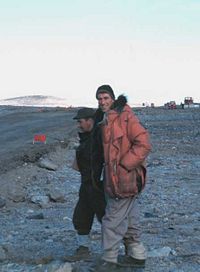
Hillary climbed ten other peaks in the Himalayas on further visits in 1956, 1960–1961, and 1963–1965. He also reached the South Pole as part of the Commonwealth Trans-Antarctic Expedition, for which he led the New Zealand section, on January 4, 1958. His party was the first to reach the Pole overland since Amundsen in 1911 and Robert F. Scott in 1912, and the first ever to do so using motor vehicles. In 1977, he led a jetboat expedition, titled "Ocean to Sky," from the mouth of the Ganges River to its source.
| “ | True, why make a fuss over something that's done anyway? I was never one to obsess about the past. Too much to do in the future! | ” |
—Hillary about his reaction to the destruction of one of the jetboats by his friend Jim Wilson |
||
In 1979, as he had done previously,[22] Hillary was scheduled to act as a commentator on the ill-fated Air New Zealand Flight 901, an Antarctic sightseeing flight, but had to pull out due to work commitments elsewhere. He was replaced by his close friend Peter Mulgrew, who perished as the aircraft crashed on Mount Erebus, killing all 257 on board.[23] A decade later married Mulgrew's widow.[24][25]
Hillary took part in the 1975 general election, as a member of the "Citizens for Rowling" campaign. His involvement in this campaign was seen as precluding his nomination as Governor-General,[26] with the position instead being offered to Keith Holyoake in 1977. However, in 1985 he was appointed New Zealand High Commissioner to India (concurrently High Commissioner to Bangladesh and Ambassador to Nepal) and spent four and a half years based in New Delhi. In 1985 he accompanied Neil Armstrong in a small twin-engined ski plane over the Arctic Ocean and landed at the North Pole. He thus became the first man to stand at both poles and on the summit of Everest.[27][28][29]
In January 2007, Hillary traveled to Antarctica to commemorate the 50th anniversary of the founding of Scott Base. He flew to the station on January 18, 2007 with a delegation including the Prime Minister. [30][31] While there he called for the British government to contribute to the upkeep of Scott's and Shackleton's huts. On April 22, 2007 while on a trip to Kathmandu he is reported to have suffered a fall. There was no comment on the nature of his illness and he did not immediately seek treatment. He was hospitalized after returning to New Zealand.[32]
Public Recognition
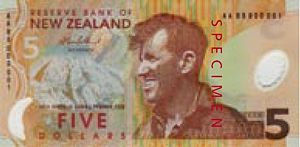
Hillary was created a Knight Commander of the Order of the British Empire (KBE) on June 6, 1953;[19] a member of the Order of New Zealand (ONZ) in 1987; and a Knight of the Order of the Garter (KG) on April 22, 1995.[33] He was also awarded the Polar Medal for his part in the Commonwealth Trans-Antarctic Expedition.[34] His favored New Zealand charity was the Sir Edmund Hillary Outdoor Pursuits Centre of New Zealand of which he was Patron for 35 years. Hillary was particularly keen on the work this organization did in introducing young New Zealanders to the outdoors in a very similar way to his first experience of a school trip to Mount Ruapehu at the age of 16. Various streets, schools and organizations around New Zealand and abroad are named after him. A few examples are Hillary College (Otara), Edmund Hillary Primary School (Papakura) and the Hillary Commission (now SPARC).
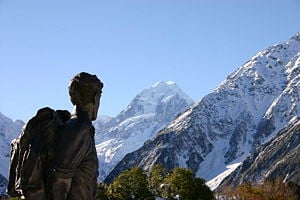
In 1992 Hillary appeared on the updated New Zealand $5 note, thus making him the only New Zealander to appear on a banknote during his or her lifetime, in defiance of the established convention for banknotes of using only depictions of deceased individuals, and current heads of state. The Reserve Bank governor at the time, Don Brash, had originally intended to use a deceased sportsperson on the $5 note but could not find a suitable candidate. Instead he broke with convention by requesting and receiving Hillary's permission — along with an insistence from Hillary to use Aoraki/Mount Cook rather than Mount Everest in the backdrop. The image also features a Ferguson TE20 tractor like the one Hillary used to reach the South Pole on the Commonwealth Trans-Antarctic Expedition.
To mark the occasion of the 50th anniversary of the first successful ascent of Everest the Nepalese Government conferred honorary citizenship upon Hillary at a special Golden Jubilee celebration in Kathmandu. He was the first foreign national to receive such an honor from the Nepalese government.
In 2008, the same year he died, the Indian Government conferred him with Padma Vibhushan, the second highest civilian honor of the country.[36]
A 2.3-meter (7.5 ft) bronze statue of "Sir Ed" was installed outside The Hermitage hotel at Mt Cook village, New Zealand, in 2003.
Two Antarctic features are named after Hillary. The Hillary Coast is a section of coastline south of Ross Island and north of the Shackleton Coast. It is formally recognized by New Zealand, the United States of America and Russia. The Hillary Canyon, an undersea feature in the Ross Sea appears on the General Bathymetric Chart of the Oceans, which is published by the International Hydrographic Organization.
Family Life
Hillary married Louise Mary Rose on September 3, 1953, soon after the ascent of Everest. A shy man, he relied on his future mother-in-law to propose on his behalf.[8][7][37] They had three children: Peter (1954), Sarah (1955) and Belinda (1959). His wife died in (1975).[13][2] In 1975 while en route to join Hillary in the village of Phaphlu, where he was helping to build a hospital, Louise and Belinda were killed in a plane crash near Kathmandu airport shortly after take-off.[7] Hillary married June Mulgrew, the widow of his close friend Peter Mulgrew, on December 21, 1989.[8][38] His son Peter Hillary has also become a climber, conquering Everest in 1990. In April 2003 Peter and Jamling Tenzing Norgay (son of Tenzing) climbed Everest as part of a 50th anniversary celebration.[39] Hillary had six grandchildren, altogether.
Philanthropy
Following his ascent of Everest he devoted much of his life to helping the Sherpa people of Nepal through the Himalayan Trust, which he founded. Through his efforts many schools and hospitals were built in this remote region of the Himalayas. He was the Honorary President of the American Himalayan Foundation,[40] a United States non-profit body that helps improve the ecology and living conditions in the Himalayas.
Hillary spoke of his disdain for the attitudes displayed by many modern mountaineers. In particular he publicly criticized New Zealander Mark Inglis and 40 other climbers who, in various groups, left British climber David Sharp to die in May 2006. He said:
I think the whole attitude towards climbing Mount Everest has become rather horrifying. The people just want to get to the top. They don't give a damn for anybody else who may be in distress and it doesn't impress me at all that they leave someone lying under a rock to die.[41]
Death
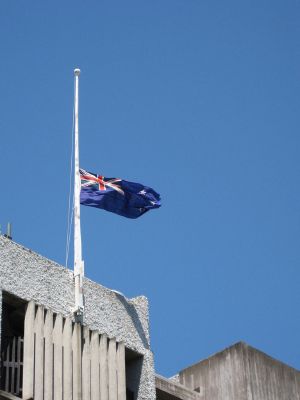
On January 11, 2008, Hillary died of heart failure at the Auckland City Hospital at around 9A.M. NZDT (January 10 at 20:00 UTC) at the age of 88.[42] Hillary's death was announced by New Zealand Prime Minister Helen Clark at around 11:20A.M. She stated that his passing was a "profound loss to New Zealand."[43] His death was recognized by the lowering of flags to half-mast on all Government and public buildings and at Scott Base in Antarctica.[44] Actor and adventurer Brian Blessed, who attempted to climb Everest three times, described Sir Edmund as a "kind of titan."[45] He was in hospital at the time of his death but was expected to come home that day according to his family.[45][46][47][48][49][50][51] The local press emphasized Hillary's humble and congenial personality and his life of hard work.[52][53]
In tribute Claire Harvey wrote in the January 12, 2008 New Zealand Herald "and for New Zealanders, Sir Ed was everything a good bastard ought to be - modest and humorous, brave and compassionate, and just grouchy enough to remind us he never sought, nor particularly enjoyed, adulation."
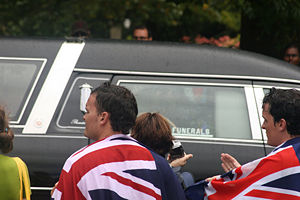
After Hillary's death the Green Party proposed a new public holiday for July 20 or the Monday nearest to it.[54] Renaming mountains after Hillary was also proposed. The Mt Cook Village's Hermitage Hotel, the Sir Edmund Hillary Alpine Centre and Alpine Guides, proposed a renaming of Mount Ollivier, the first mountain climbed by Hillary. The family of Arthur Ollivier, for whom the mountain is named, are against such a renaming.[55]
Funeral
A state funeral was held for Hillary on January 22, 2008,[56] after which his body was cremated. The first part of this funeral was on January 21, when Hillary's casket was taken into Holy Trinity Cathedral to lie in state.[57] On February 29, 2008, in a private ceremony, Hillary's ashes were scattered in Auckland's Hauraki Gulf as he had desired.[58]
On April 2, 2008, a service of thanksgiving was held in his honor at St George's Chapel in Windsor Castle. It was attended by the Queen (but not the Duke of Edinburgh owing to a chest infection) and New Zealand dignitaries including Prime Minister Helen Clark. Sir Edmund's family and family members of Tenzing Norgay attended as well, many of whom spoke about their memories of the great mountaineer. Gurkha soldiers from Nepal, a country Sir Edmund Hillary held much affection for, stood guard outside the ceremony.[59][60]
Tribute
There have been many calls for lasting tributes to Sir Edmund Hillary. The first major public tribute has been by way of the "Summits for Ed" tribute tour organized by the Sir Edmund Hillary foundation[61] This tribute tour went from Bluff at the bottom of the South Island to Cape Reinga at the tip of the North Island, visiting 39 towns and cities along the way. In each venue school children and members of the public were invited to join together to climb a significant hill or site in their area to show their respect for Hillary. Public were also invited to bring small rocks or pebbles that had special significance to them, that would be collected and included in a memorial to Hillary at the base of Mount Ruepehu in the grounds of the Sir Edmund Hillary Outdoor Pursuits Centre. Any funds donated during the tour are to be used by the foundation to sponsor young New Zealanders on outdoor courses to continue the values that Hillary espoused. Over 10,000 members of the public attended these "Summit" climbs.
Legacy
Hillary was a revolutionary explorer whose travels helped to bring about a better understanding of the global community as a whole. His travels aided in creating a more holistic picture of world geography. Hillary, along with Tenzing Norgay, was one of the first to reach the majestic heights of Mount Everest. This expedition alone propelled him to a status of renowned fame. Hillary partook in several other expeditions during his lifetime, one of which was a trek to the far reaches of the South Pole. Hillary would also make his way to the opposite end of the globe and reach the distant North Pole before his death. Hillary aided communities of indigenous Himalayan peoples and provided numerous facilities for their greater well-being. He was successful in persuading the Nepalese government to institute important reforms for these peoples. For one man, Hillary's travels are remarkable. His dedication to environmental and humanitarian concerns and efforts also deserve to be recognized.
Publications
Books written by Hillary include:
- High Adventure. 1955. Oxford: Oxford University Press. ISBN 1932302026
- High Adventure: The True Story of the First Ascent of Everest. [1955] 2003. Oxford: Oxford University Press. ISBN 0195167341
- East of Everest - An Account of the New Zealand Alpine Club Himalayan Expedition to the Barun Valley in 1954, with George Lowe. 1956. New York: E. P. Dutton and Company, Inc. ASIN B000EW84UM
- No Latitude for Error. 1961. London: Hodder & Stoughton. ASIN B000H6UVP6
- The New Zealand Antarctic Expedition. 1959. Nelson, NZ: R.W. Stiles, printers. ASIN B0007K6D72
- The Crossing of Antarctica; the Commonwealth Transantarctic Expedition, 1955-1958, with Sir Vivian Fuchs. 1958. London: Cassell. ASIN B000HJGZ08
- High in the thin cold air; the story of the Himalayan Expedition, led by Sir Edmund Hillary, sponsored by World Book Encyclopedia, with Desmond Doig. 1963. New York: Doubleday. ASIN B00005W121
- Schoolhouse in the Clouds. 1965. New York: Doubleday. ASIN B00005WRBB
- Nothing Venture, Nothing Win. 1975. London: Hodder & Stoughton General Division. ISBN 0340212969
- From the Ocean to the Sky: Jet Boating Up the Ganges. 1980. Leicester: Ulverscroft Large Print Books Ltd. ISBN 0708905870
- Two Generations, with Peter Hillary. 1984. London: Hodder & Stoughton Ltd. ISBN 0340354208
- Ascent: Two Lives Explored: The Autobiographies of Sir Edmund and Peter Hillary. 1992. St. Paul, MN: Paragon House Publishers. ISBN 1557784086
- View from the Summit: The Remarkable Memoir by the First Person to Conquer Everest. 2000. New York: Pocket. ISBN 0743400674
Notes
- ↑ Sputnik I was launched in 1957.
- ↑ 2.0 2.1 2.2 2.3 Famous New Zealanders. Christchurch City Libraries. Retrieved September 24, 2008.
- ↑ 3.0 3.1 3.2 The early years - Ed Hillary. Ministry for Culture and Heritage, Wellington, New Zealand. Retrieved September 24, 2008.; New Zealand History online - Nga korero aipurangi o Aotearoa Ministry for Culture and Heritage, Wellington, New Zealand. Retrieved September 24, 2008.
- ↑ Heather Tyler, 2005. Authorised Hillary biography reveals private touches. NZ Herald. Retrieved September 24, 2008.
- ↑ Simon Robinson, Jan. 10, 2008. Sir Edmund Hillary: Top of the World. TIME Retrieved September 24, 2008.
- ↑ 6.0 6.1 Philippe Naughton, January 11, 2008. Hillary mourned, both in Nepal and New Zealand. Times Online. Retrieved September 24, 2008.
- ↑ 7.0 7.1 7.2 Robert Sullivan, 2003. Sir Edmund Hillary—A visit with the world's greatest living adventurer. TIME. Retrieved September 24, 2008.
- ↑ 8.0 8.1 8.2 Peter Miller, Everest: 50 Years and Counting National Geographic. Retrieved September 24, 2008.
- ↑ 9.0 9.1 Peter Calder, 2008. Sir Edmund Hillary's life. NZ Herald. Retrieved September 24, 2008.
- ↑ 10.0 10.1 10.2 10.3 10.4 10.5 10.6 Edmund Hillary, 2003. High Adventure: The True Story of the First Ascent of Everest. (Oxford, UK; New York, NY: Oxford University Press. ISBN 9780195167344.)
- ↑ Hillary of New Zealand and Tenzing reach the top Reuter. Retrieved September 24, 2008.
- ↑ 12.0 12.1 REACHING THE TOP. Royal Geographical Society. Retrieved September 24, 2008.
- ↑ 13.0 13.1 Sir Edmund Hillary—KING OF THE WORLD. The New Zealand Edge. Retrieved September 24, 2008.
- ↑ Edmund Hillary, and Peter Hillary. 1986. Ascent: Two Lives Explored: The Autobiographies of Sir Edmund and Peter Hillary. (Garden City, NY: Doubleday. ISBN 9780385198318.)
- ↑ Everest not as tall as thought. Agençe France-Presse. Retrieved September 24, 2008.
- ↑ 16.0 16.1 Audrey Salkeld, 2000. First to Summit. PBS/NOVA. Retrieved September 24, 2008.
- ↑ In 1999, George Mallory's well preserved frozen body was found at the 27,000 ft level. His camera was not located, and if is ever found, the film inside could provide a definitive answer to whether he and Sandy Irvine summited Everest in 1924. "Because it's there," - George Leigh Mallory. EverestNews.com. Retrieved September 24, 2008.
- ↑ Joanna Wright, The Photographs from Everest, Summit of Achievement. Imaging Everest. Retrieved September 24, 2008.
- ↑ 19.0 19.1 London Gazette 39886:3273.
- ↑ 20.0 20.1 Peter H. Hansen, "Tenzing Norgay (Sherpa Tenzing) (1914–1986)." Oxford Dictionary of National Biography. (Oxford University Press.)
- ↑ Paul Vallely, 1986. Man of the mountains Tenzing. The Times.
- ↑ The Antarctic experience - Erebus disaster. New Zealand History Online. Retrieved September 24, 2008.
- ↑ Sir Edmund Hillary: A Tribute. Radio New Zealand. Retrieved September 24, 2008.
- ↑ On top of the world: Ed Hillary - Full biography of Edmund Hillary. New Zealand History Online. Retrieved September 24, 2008.
- ↑ Edmund Hillary Biography. NZEdge. Retrieved September 24, 2008.
- ↑ Henderson. 1980.
- ↑ Robert Sullivan, 2003. TIME: The Greatest Adventures of All Time - The Race to the Pole. TIME. Retrieved September 19, 2008. Interview with Edmund Hillary.
- ↑ David Fickling, 2003. Portrait - 'We knocked the bastard off'. The Guardian. Retrieved September 24, 2008. Interview with Edmund Hillary.
- ↑ Video: Interview on HardTalk. BBC News. Retrieved September 24, 2008.
- ↑ Claire Harvey, 2007. Claire Harvey on Ice: Mt Erebus sends chills of horror. The New Zealand Herald. Retrieved January 21, 2007.
- ↑ PM and Sir Edmund Hillary off to Scott Base. Radio Network. Retrieved September 24, 2008.
- ↑ Stuart Dye, Clark sends goodwill message to Sir Edmund. The New Zealand Herald. Retrieved September 24, 2008.
- ↑ London Gazette. 54017:6023.
- ↑ London Gazette. 41384:2997.
- ↑ Explaining Currency. NZ Government. Retrieved September 24, 2008.
- ↑ 119 get Padma Awards. Hindustan Times. Retrieved September 24, 2008.
- ↑ Famous New Zealanders. Christchurch City Libraries. Retrieved September 24, 2008.
- ↑ Sir Edmund Hillary to Start Rolex Sydney-Hobart Race. Sailing Source. Retrieved September 24, 2008.
- ↑ Everest: To the Top of the World. NPR. Retrieved September 24, 2008.
- ↑ [1].American Himalayan Foundation. Retrieved October 29, 2008.
- ↑ Sasha Shtargot, and Janine Bennetts. 2006. Death on Everest divides climbers. The Age. Retrieved September 24, 2008.
- ↑ State funeral for Sir Edmund Hillary. New Zealand Herald. Retrieved September 24, 2008.
- ↑ Clark statement on Hillary death. CNN. Retrieved September 25, 2008.
- ↑ Flag flies at half-mast over a sad Scott Base. Stuff.co.nz. Retrieved September 25, 2008.
- ↑ 45.0 45.1 Obituary. Lastingtribute.co.uk. Retrieved September 25, 2008.
- ↑ Jim Perrin, Obituary. The Guardian.uk. Retrieved September 25, 2008.
- ↑ Obituary. The Daily Telegraph.uk. Retrieved September 25, 2008.
- ↑ Obituary. The Times. Retrieved September 25, 2008.
- ↑ Coverage Online. The Times.uk. Retrieved September 25, 2008.
- ↑ Obituary. The Economist. Retrieved September 25, 2008.
- ↑ "First man to scale Everest, Sir Edmund Hillary, dies." The Straits Times (Singapore).
- ↑ We will not see his kind again. TVNZ. Retrieved September 25, 2008.
- ↑ World's media honours Hillary. New Zealand Herald. Retrieved September 25, 2008.
- ↑ Green Party of Aotearoa New Zealand Press Release, January 14, 2008. Annual Sir Edmund Hillary Day a fitting tribute. Scoop.co.nz. Retrieved September 25, 2008.
- ↑ Renaming peak for Sir Ed meets resistance. New Zealand Herald. Retrieved September 25, 2008.
- ↑ State funeral for Sir Ed. Stuff.co.nz. Retrieved September 25, 2008.
- ↑ Sir Edmund Hillary lies in state. Stuff.co.nz. Retrieved September 25, 2008.
- ↑ Sir Edmund Hillary takes final voyage, ashes scattered at sea. New Zealand Herald. Retrieved September 25, 2008.
- ↑ In pictures: Sir Edmund Hillary service. BBC News. Retrieved September 25, 2008.
- ↑ Third night in hospital for duke. BBC News. Retrieved September 25, 2008.
- ↑ [2].
References
ISBN links support NWE through referral fees
- BBC News. In pictures: Sir Edmund Hillary service. Retrieved October 6, 2020.
- BBC News. Third night in hospital for duke. Retrieved October 6, 2020.
- BBC News. Video: Interview on HardTalk. Retrieved October 6, 2020.
- Christchurch City Libraries. Famous New Zealanders. Retrieved September 25, 2008.
- Christchurch City Libraries. Famous New Zealanders: 2. Retrieved September 25, 2008.
- CNN.com. Clark statement on Hillary death. Retrieved October 6, 2020.
- The Daily Telegraph. 2008. Retrieved September 25, 2008.
- The Economist. Retrieved October 6, 2020.
- EverestNews.com. "Because it's there," - George Leigh Mallory. Retrieved October 6, 2020.
- Fickling, David. Portrait - 'We knocked the bastard off'. The Guardian. 2003. Retrieved October 6, 2020.
- France-Presse, Agençe. Everest not as tall as thought. ABC Australia. Retrieved October 6, 2020.
- Green Party of Aotearoa New Zealand Press Release. Annual Sir Edmund Hillary Day a fitting tribute. Scoop.co.nz. 2008. Retrieved October 6, 2020.
- Hansen, Peter H. "Tenzing Norgay [Sherpa Tenzing] (1914–1986)." Oxford Dictionary of National Biography. Oxford, UK; New York, NY: Oxford University Press, 2004.
- London Gazette 39886:3273.
- London Gazette 54017:6023.
- London Gazette 41384:2997.
- Ministry for Culture and Heritage, Wellington, New Zealand. The early years - Ed Hillary. Retrieved October 6, 2020.
- New Zealand History Online. The Antarctic experience - Erebus disaster. Retrieved October 6, 2020.
- New Zealand History Online. On top of the world: Ed Hillary - Full biography of Edmund Hillary Retrieved October 6, 2020.
- Perrin, Jim. Obituary. The Guardian. Retrieved October 6, 2020.
- Salkeld, Audrey. First to Summit. PBS/NOVA. 2000. Retrieved October 6, 2020.
- Shtargot, Sasha, and Janine Bennetts. Death on Everest divides climbers. The Age. 2006. Retrieved October 6, 2020.
- The Straits Times (Singapore). "First man to scale Everest, Sir Edmund Hillary, dies." October 6, 2020.
- Vallely, Paul. "Man of the mountains Tenzing." The Times. 1986.
- Wright, Joanna. Everest, Summit of Achievement, by the Royal Geographic Society. New York, NY: Simon & Schuster, 2003. ISBN 0743243862. Retrieved October 6, 2020.
External links
All links retrieved September 25, 2017.
- Videos from Archives New Zealand
Credits
New World Encyclopedia writers and editors rewrote and completed the Wikipedia article in accordance with New World Encyclopedia standards. This article abides by terms of the Creative Commons CC-by-sa 3.0 License (CC-by-sa), which may be used and disseminated with proper attribution. Credit is due under the terms of this license that can reference both the New World Encyclopedia contributors and the selfless volunteer contributors of the Wikimedia Foundation. To cite this article click here for a list of acceptable citing formats.The history of earlier contributions by wikipedians is accessible to researchers here:
- Edmund Hillary history
The history of this article since it was imported to New World Encyclopedia:
- History of "Edmund Hillary"
Note: Some restrictions may apply to use of individual images which are separately licensed.
↧ Download as ZWI file | Last modified: 02/04/2023 06:12:13 | 3 views
☰ Source: https://www.newworldencyclopedia.org/entry/Edmund_Hillary | License: CC BY-SA 3.0
 ZWI signed:
ZWI signed: KSF
KSF